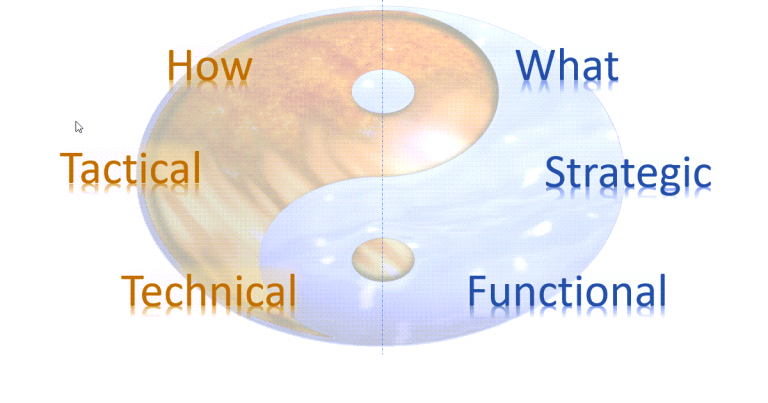Can Product Managers also be Product Owners?
This post explores the challenges of tasking tech product managers (PMs) to context-switch between strategic focus required in product management roles and tactical focus required in product ownership roles (also known as business analysis or board ownership roles). These apply to the development of software applications, SaaS products and managed service offerings.
The Spectrum Spanning PMs and POs
A product manager is a customer-facing role dedicated to ensuring that a product offers optimal functionality, capacity, features and utility to customers in the present and future. This entails constant attention focused on customers to perceive their needs, combined with continuously prioritizing those needs for development in a way that is congruent with a company’s short and long-term strategies.
At the opposite end of this spectrum, a product owner is a team-facing role, derived from the development framework known as Scrum. For shops, teams or departments that use other methodologies, Lean Kanban might call this role a board owner, and Waterfall might call it a business analyst. Regardless of the role title, it entails the work of analyzing and progressively elaborating specs and stories for the needs prioritized by product managers, so that designers and developers can produce and continuously evolve products that fulfill customers’ needs.
Can these roles be played by the same person?
Yes.
In fact, there are benefits to this being the same person. The first benefit is obvious – lower headcount without the need for a second person in the functional space of a team.
With that, wearing the PM and PO hat simultaneously, an individual can make a decision about a feature based on customer research or field work, and immediately go heads-down to write specs and stories to go develop it. No synchronous meetings or time investment required.
Today’s shops often organize their teams by starting out this way. However, the need to supplement this single individual playing two distinct roles can sneak up on you (see below).
Can there be challenges when they are the same person?
Yes. Both have to do with context switching becoming excessive.
The first challenge crops up when customer needs are complex. Sometimes this has to do with the prioritized feature or functionality itself. Examples include complex workflows and wizards to perform business tasks, or complex mathematics to make calculations in science, finance or tax work.
The second challenge has to do with the complexity of a product’s industry. High complexity can be found in infrastructure as a service, professional services, education, accounting, finance, and tax prep to name a few. In these instances, the product owner task work of elaborating business rules, calculation, workflows and user interfaces can require the full-time focus of a skilled individual in the PO role that is separate from the role of product manager.
How do I know I need a PM and a PO?
The first sign of this will show up in your speed-of-development. If the product owner role is overburdened in your product development shop, whether it is being played by your PM, or by other dev team/technical team members trying to help out, you will see development productivity that goes through peaks and valleys. What you are seeing is your team’s bursts as they burn through ready specs, and lulls due to slowing down to learn the specs, articulate them and organize them for delivery. This signals that you are running out of ready stories to keep your team optimally producing, and you need to make a change.
The next signal will be a lack of vision and long-term strategy in your product management division. This can be hard to identify. Often, overburdened product managers downshift into approaching their roadmaps as lists of features rather than a comprehensive plan that takes into account the needs of customers today, tomorrow and in future facets of company strategy. Planning product strategy takes heads-down time, and writing specs cuts into that. You know that product managers need to reduce context switching and team up with POs when they resort to order-taking over visioning and planning.
The third signal to look for is product manager morale. This can be a downward spiral when the two scenarios above both contribute to this realm negatively. For example, when speed of development is inconsistent and unpredictable, the priorities for a product manager’s customers and stakeholders fall behind, and they have to answer for shortcomings. Meanwhile, when they are too overburdened to plan, they feel out of control as they begin to perceive competitors and market forces overwhelming their roadmaps. Somehow, they know innately that failing to plan is planning to fail, and this tends to show up in their morale when they are too overburdened to plan.
Closing
Does your shop have these challenges with overburdened PMs? If you do, you might consider a trial period with a PO, and look to see if some of the symptoms listed above subside for you.
Mike Liskow is a business development consultant, writer, artist, entrepreneur and thought leader in the business development space for tech startups.
D'Mention Systems was established in 2003 and provides business development consulting engagements for tech startups.






